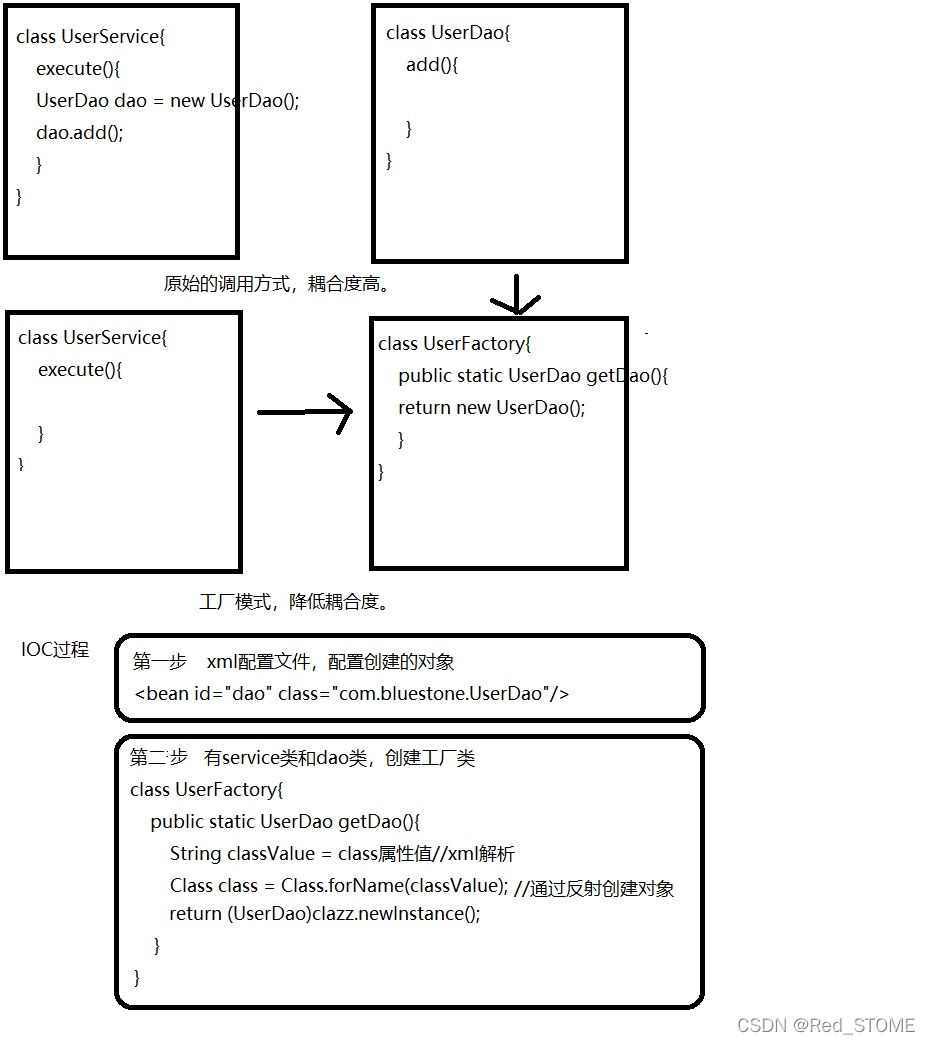spring(IOC之xml配置部分)
文章目录
框架概述
1.Spring是一个轻量级的,开源的JavaEE应用程序框架。
2.Spring是用来解决企业应用开发的复杂性。
3.具有两个核心部分:IOC和Aop
ⅠIOC:控制反转,把创建对象过程交给Spring进行管理
ⅡAop:面向切面,不修改源代码进行功能增加。
4.Spring特点
Ⅰ方便解耦,简化开发
ⅡAop程序支持
Ⅲ方便继承
Ⅳ方便和其他框架进行整合
Ⅴ方便事务操作
Ⅵ降低API开发难度
IOC容器
1.IOC底层原理

IOC也称控制反转(Inversion of Control),把对象创建和对象之间的调用过程交给Spring进行管理,可以降低代码的耦合度。
xml解析、工厂模式、反射。
2.IOC接口(BeanFactory)
1.IOC思想基于IOC容器来完成。IOC容器底层就是对象工厂
2.Spring提供了IOC容器实现的两种方式(两种接口)
ⅠBeanFactory:IOC容器的基本实现,是Spring内部的使用接口,不提供开发人员进行使用。
*加载配置文件的时候不会创建对象,在获取对象(使用)的时候才去创建对象。
ⅡApplicationContext:BeanFactory接口的子接口,提供了更多更强大的功能,一般是由开发人员进行使用的。
*加载配置文件的时候就会把在配置文件对象进行创建。
3.ApplicationContext接口有实现类

FileSystemXmlApplicationContext类是对应的计算机内具体路径下的配置文件
ClassPathXmlApplicationContext类是项目文件下的配置文件名

3.IOC操作Bean管理
1.Bean管理概念
1.Spring创建对象
2.Spring注入属性
2.Bean管理操作
Ⅰ基于xml配置文件方式实现
(1)在spring配置文件中,使用bean标签,标签里面添加对应属性,就可以实现对象创建。
(2)在bean标签中有许多属性,介绍一些常用属性。
①id属性:唯一标识
②class属性:类全路径(包类路径)
③name属性:可以加特殊符号作用与id属性相同
(3)创建对象时,默认也是执行无参数构造方法。
(4)注入属性:
①set化注入
step1:
//创建属性
private String bname;
private String bauthor;
//创建set方法
public void setBname(String bname){
this.bname = bname;
}
public void setBauthor(String bauthor){
this.bauthor = bauthor;
}
step2:
<!--使用set方法注入属性-->
<bean id="books" class="com.bluestone.spring5.book">
<!--使用property完成属性注入-->
<property name="bauthor" value="bluestone"/>
<property name="bname" value="HHH"/>
</bean>
②有参构造注入
step1:
public class Order {
public String onames;
public String address;
public Order(String onames,String address){
this.address=address;
this.onames=onames;
}
}
step2:
<bean id="order" class="com.bluestone.spring5.Order">
<constructor-arg index="0" value="bluestone"/>
<constructor-arg index="1" value="XX省XX市"/>
<constructor-arg name="address" value=""/>
<constructor-arg name="onames" value=""/>
</bean>
③p名称空间注入
可以简化基于xml配置的方式
step1:添加一个p名称空间
<beans xmlns="http://www.springframework.org/schema/beans"
xmlns:xsi="http://www.w3.org/2001/XMLSchema-instance"
xmlns:p="http://www.springframework.org/schema/p"
xsi:schemaLocation="http://www.springframework.org/schema/beans http://www.springframework.org/schema/beans/spring-beans.xsd">
</beans>
step2:进行属性注入,在bean标签内操作
<bean id="books" class="com.bluestone.spring5.book" p:bauthor="HH" p:bname="AA">
</bean>
④xml类型的其他类型注入
1.赋值为null值
<property name="author">
<null/>
</property>
2.属性值包括特殊符号
<!--1.用转义符号< >分别代表小于号和大于号-->
<!--2.把特殊符号写道CDATA-->
<property name="address">
<value><![CDATA[<<忽略检查的文本>>]]></value>
</property>
⑤注入属性外部bean
step1:创建两个类service类和dao类
//service包内
public class UserService {
public void add(){
System.out.println("Service add ..........");
//原始方式:创建UserDao对象
//UserDao userDao = new UserDaoImpl();
//userDao.update();
}
}
//Dao包内
public interface UserDao {
public void update();
}
public class UserDaoImpl implements UserDao{
@Override
public void update() {
System.out.println("Sercice update ..........");
}
}
step2:在service里面调用dao的方法
public class UserService {
private UserDao userDao;
public void setUserDao(UserDao userDao){
this.userDao = userDao;
}
public void add(){
System.out.println("Service add ..........");
//原始方式:创建UserDao对象
//UserDao userDao = new UserDaoImpl();
//userDao.update();
userDao.update();
}
}
step3:在Spring的配置文件中进行配置
<bean id="userService" class="com.bluestone.service.UserService">
<!--注入userDao对象
name属性值:类里面属性名称
ref属性值:创建userDao对象的bean标签id值-->
<property name="userDao" ref="userDaoImpl"/>
</bean>
step4:测试
@Test
public void TestBean(){
ApplicationContext context = new ClassPathXmlApplicationContext("xml/bean2.xml");
UserService userService = context.getBean("userService",UserService.class);
userService.add();
}
⑥xml注入集合属性
通常来说不同的属性在配置文件中都用自身所对应的标签,可以在idea快捷输入中找到
Ⅰ注入数组类型
Ⅱ注入List类型
Ⅲ注入Map类型
Ⅳ注入Set类型
step1:创建类,定义相关的类型
private String[] name;
private List<String> lists;
private Map<String,String> maps;
private Set<String> sets;
public void setSets(Set<String> sets) {
this.sets = sets;
}
public void setName(String[] name) {
this.name = name;
}
public void setLists(List<String> lists) {
this.lists = lists;
}
public void setMaps(Map<String, String> maps) {
this.maps = maps;
}
public String[] getName() {
return name;
}
public List<String> getLists() {
return lists;
}
public Map<String, String> getMaps() {
return maps;
}
public Set<String> getSets() {
return sets;
}
step2:编写配置文件
<bean id="stu" class="com.bluestone.spring5.stu">
<property name="name">
<array>
<value>张三</value>
<value>李四</value>
<value>王五</value>
</array>
</property>
<property name="lists">
<list>
<value>Java</value>
<value>Spring</value>
</list>
</property>
<property name="maps">
<map>
<entry key="JAVA" value="java"/>
<entry key="Spring" value="spring"/>
</map>
</property>
<property name="sets">
<set>
<value>mysql</value>
<value>redis</value>
</set>
</property>
</bean>
⑦在集合中设置对象值
与其上中填入的在变量中加入对象同理,只需要将value标签更改为ref标签并且在配置文件中声明过bean对象即可。
<property name="course">
<list>
<ref bean="Course1"/>
<ref bean="Course2"/>
</list>
</property>
</bean>
<bean id="Course1" class="com.bluestone.spring5.Course">
<property name="name" value="spring"/>
</bean>
<bean id="Course2" class="com.bluestone.spring5.Course">
<property name="name" value="mybatis"/>
</bean>
⑧提取集合注入部分
step1:再spring的配置文件中先引入一个名称空间
<?xml version="1.0" encoding="UTF-8"?>
<beans xmlns="http://www.springframework.org/schema/beans"
xmlns:xsi="http://www.w3.org/2001/XMLSchema-instance"
xmlns:util="http://www.springframework.org/schema/util"
xsi:schemaLocation="http://www.springframework.org/schema/beans http://www.springframework.org/schema/beans/spring-beans.xsd
http://www.springframework.org/schema/util http://www.springframework.org/schema/beans/spring-util.xsd">
</beans>
step2:
<util:list id="book_list">
<value>1</value>
<value>2</value>
</util:list>
<bean id="book" class="com.bluestone.spring5.book">
<property name="bname1" ref="book_list"/>
</bean>
⑨FactoryBean
Spring中有两种Bean,一种是人为创建的普通Bean,另一种是工厂Bean。
普通Bean:再配置文件中,定义的是什么类型返回的就是什么类型
工厂Bean:再配置文件中,定义Bean类型可以和返回类型不一样。
实现:
step1:创建类,让这个类作为工厂bean,实现接口FactoryBean
step2:实现接口里面的方法,再实现的方法中定义返回的bean类型。
public class MyBean implements FactoryBean {
@Override
public boolean isSingleton() {
return FactoryBean.super.isSingleton();
}
//定义返回Bean
@Override
public Object getObject() throws Exception {
D d = new D();
d.setName("spring");
return d;
}
@Override
public Class<?> getObjectType() {
return null;
}
}
3.Bean的作用域
1.在Spring中,设置创建bean实例是单实例还是多实例
2.在Spring中,默认情况下,bean是单实例对象。
验证:

由输出结果可以看出来,即使声明了多个对象但是他们的输出地址还是相同的,他们的实例并没有发生改变,所以默认情况下bean是单实例对象。
3.如何设置单实例还是多实例
Ⅰ在spring配置文件bean标签里面有属性(scope)用于设置单实例还是多实例
Ⅱscope属性值
第一个值 默认值,singleton,表示是单实例对象。
第二个值prototype,表示是多实例对象
<bean id="book" class="com.bluestone.spring5.book" scope="prototype">
<property name="bname1" ref="book_list"/>
</bean>

改后再次测试,则发现两次输出的地址值改变了,因此转化为多实例对象。
4.Bean生命周期
基本生命周期
1.通过构造器创建bean实例(无参数构造)
2.为bean的属性设置值和对其他bean的引用(调用set方法)
3.调用bean的初始化方法
4.bean可以使用了(对象获取到了)
5.当容器关闭的时候,调用bean的销毁的方法(需要进行配置销毁方法)
以下为实例:
<bean id="book" class="com.bluestone.spring5.book" init-method="initmethod" destroy-method="destroymethod">
<property name="show" value="111"/>
</bean>
public class book {
//创建属性
private String show;
//创建set方法
public book(){
System.out.println("第一步,通过构造器创建bean实例");
}
public void setShow(String show){this.show=show;System.out.println("第二步,为bean的属性设置值");}
public void initmethod(){System.out.println("第三步,执行初始化方法");}
public void destroymethod(){System.out.println("第五步,执行销毁的方法");}
}
@Test
public void testbook(){
//ApplicationContext context = new ClassPathXmlApplicationContext("xml/bean3.xml");
ClassPathXmlApplicationContext context = new ClassPathXmlApplicationContext("xml/bean3.xml");
book book1 = context.getBean("book", book.class);
System.out.println("第四步,获取创建bean实例");
System.out.println(book1);
context.close();
}

bean的后置处理器
添加后置处理器后生命周期变为七层
1.通过构造器创建bean实例(无参数构造)
2.为bean的属性设置值和对其他bean的引用(调用set方法)
3.把bean的实例传递给bean的后置处理器的方法
4.调用bean的初始化方法
5.把bean实例传递bean后置处理器的方法
6.bean可以使用了(对象获取到了)
7.当容器关闭的时候,调用bean的销毁的方法(需要进行配置销毁方法)
演示效果:
(1)创建类,实现接口BeanPostProcessor,创建后置处理器。
public class MyBeanPost implements BeanPostProcessor {
@Override
public Object postProcessBeforeInitialization(Object bean, String beanName) throws BeansException {
return BeanPostProcessor.super.postProcessBeforeInitialization(bean, beanName);
}
@Override
public Object postProcessAfterInitialization(Object bean, String beanName) throws BeansException {
return BeanPostProcessor.super.postProcessAfterInitialization(bean, beanName);
}
}
(2)配置文件中声明
<!--此配置文件下声明的所有bean都存在这个bean后置处理器-->
<bean id="myBeanP" class="com.bluestone.spring5.MyBeanPost"></bean>
5.Bean自动装配:
注:实际一般都是用注解方式做自动装配
根据指定装配规则(属性名称或者属性类型),Spring自动将匹配的属性值注入
过程:
<!--实现自动装配
bean标签属性autowire,配置自动装配
autowire属性常用两个值,
byName根据属性名称注入,注入值bean的id值和类属性名称一样
byType根据属性类型注入,使用byType时相同类型的类不能定义多个,定义多个会导致错误
-->
<bean id="emp" class="com.bluestone.autowire.Emp" autowire="byName">
<!--<property name="dept" ref="dept"/>-->
</bean>
byType错误类型
<bean id="emp" class="com.bluestone.autowire.Emp" autowire="byType">
<!--<property name="dept" ref="dept"/>-->
</bean>
<bean id="dept" class="com.bluestone.autowire.Dept"/>
<bean id="dept1" class="com.bluestone.autowire.Dept"/>
出现重复类型时会报如下错误:
Could not autowire. There is more than one bean of ‘Dept’ type. Beans: dept1,dept. Properties: ‘dept’
6.外部属性文件
1.直接配置数据库信息
(1)配置德鲁伊连接池
(2)引入德鲁伊连接池依赖jar包
(3)直接引入
<bean id="dataSource" class="com.alibaba.druid.pool.DruidDataSource">
<property name="driverClassName" value="com.mysql.jdbc.Driver"/>
<property name="url" value="jabd:mysql://localhost:3306/userDB"/>
<property name="username" value="root"/>
<property name="password" value="498959702"/>
</bean>
2.引入外部属性文件配置数据库连接池
(1)写入配置文件
prop.driverClass=com.mysql.jdbc.Driver
prop.jabd=mysql://localhost:3306/userDB
prop.username=root
prop.password=123456
(2)在spring中用标签引入外部文件(首先引如context名称空间)
<?xml version="1.0" encoding="UTF-8"?>
<beans xmlns="http://www.springframework.org/schema/beans"
xmlns:xsi="http://www.w3.org/2001/XMLSchema-instance"
xmlns:context="http://www.springframework.org/schema/context"
xsi:schemaLocation="http://www.springframework.org/schema/beans http://www.springframework.org/schema/beans/spring-beans.xsd
http://www.springframework.org/schema/context http://www.springframework.org/schema/context/spring-context.xsd">
(3)用标签引入外部文件
<!--引入外部属性文件-->
<context:property-placeholder location="classpath:xml/jdbc.properties"/>
<bean id="dataSource" class="com.alibaba.druid.pool.DruidDataSource">
<property name="driverClassName" value="${prop.driverClass}"/>
<property name="url" value="${prop.url}"/>
<property name="username" value="${prop.username}"/>
<property name="password" value="${prop.password}"/>
</bean>